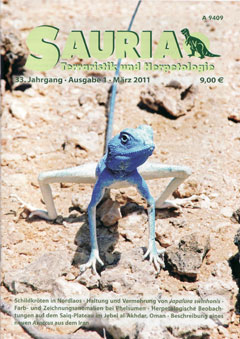Authors: TORKI, F., B. FATHINIA, H. A. ROSTAMI, A. GHARZI & F. NAZARI-SERENJEH
Source: Sauria, Issue 01/2011
Publisher: Terrariengemeinschaft Berlin e.V.


Sympatry:
At the type locality, we observed some lizards and snakes in- cluding Asaccus elisae; Laudakia nupta; Ophisops elegans, and Platyceps najadum.
Diagnosis:
A relatively large species (maximum SVL 66.2 mm); two or three pairs of postmentals, first pair of postmentals separated by mental; dorsal sides of body, neck and head (including interorbital and snout region) covered with small globular granular scales; granules on dorsum are more or less elevated and less sharp on the tail than on the back, and also less sharp than in other species of the genus Asaccus; dorsal faces of arms and legs covered with scales (not granules); scansors large; tubercles on occiput and upper head, partly also on forearm and hind limbs; upper arms without tubercles; tubercles on hind limbs moderately large to small; dorsal tubercles pointed or not; dorsolateral tubercles pointed or slightly keeled; tubercles on forearm not pointed; tubercles on hind limbs keeled or pointed; tubercles on upper head smaller than those on dorsum; digital scansors extend up to claw; distinct sexual dichromatism with the male being darker than the female; dorsal ground colour silvery in females and yellowish orange in males for which reason the orange spotted pattern is more distinct in females than in males [from TORKI et al. 2011].
Etymology:
Asaccus andersoni sp. n. is named for Steven Clement Anderson, in recognition of his major contributions to the knowledge of the herpetofauna of the Middle East and the Iranian Plateau in particular.
Per acquistare l'articolo:
